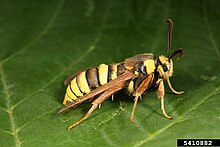| Hornet moth | |
|---|---|

| |

| |
| Scientific classification | |
| Domain: | Eukaryota |
| Kingdom: | Animalia |
| Phylum: | Arthropoda |
| Class: | Insecta |
| Order: | Lepidoptera |
| Family: | Sesiidae |
| Genus: | Sesia |
| Species: | S. apiformis
|
| Binomial name | |
| Sesia apiformis (Clerck, 1759)
| |
| Synonyms | |
| |
The hornet moth or hornet clearwing (Sesia apiformis) is a large moth native to Europe and the Middle East and has been introduced to North America.[1] Its protective coloration is an example of Batesian mimicry, as its similarity to a hornet makes it unappealing to predators. The hornet moth has been linked to the large dieback of poplar trees across Europe because its larvae bore into the trunk of the tree before re-emerging as adults.
- ^ Bella, Salvatore. "Bibliographic summary and new records of the Brachodidae and Sesiidae of Sicily, with an updated list and some comments on the distribution of Italian species (Lepidoptera, Cossoidea)". Spixiana.